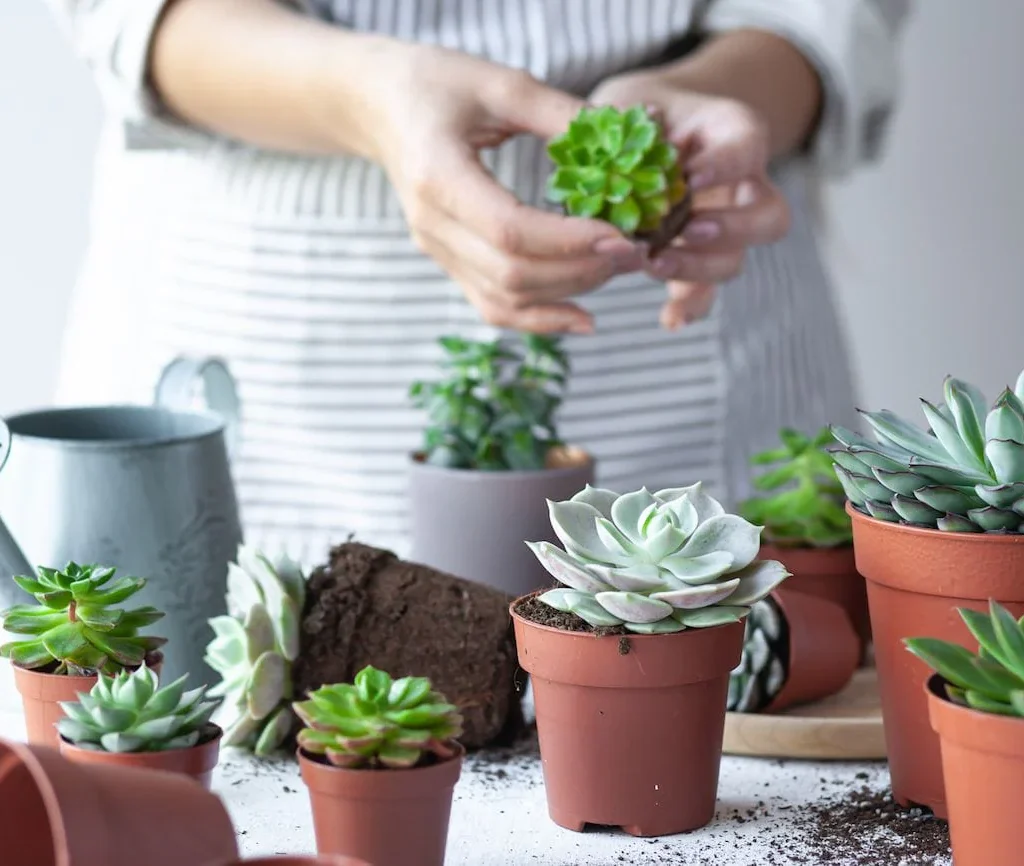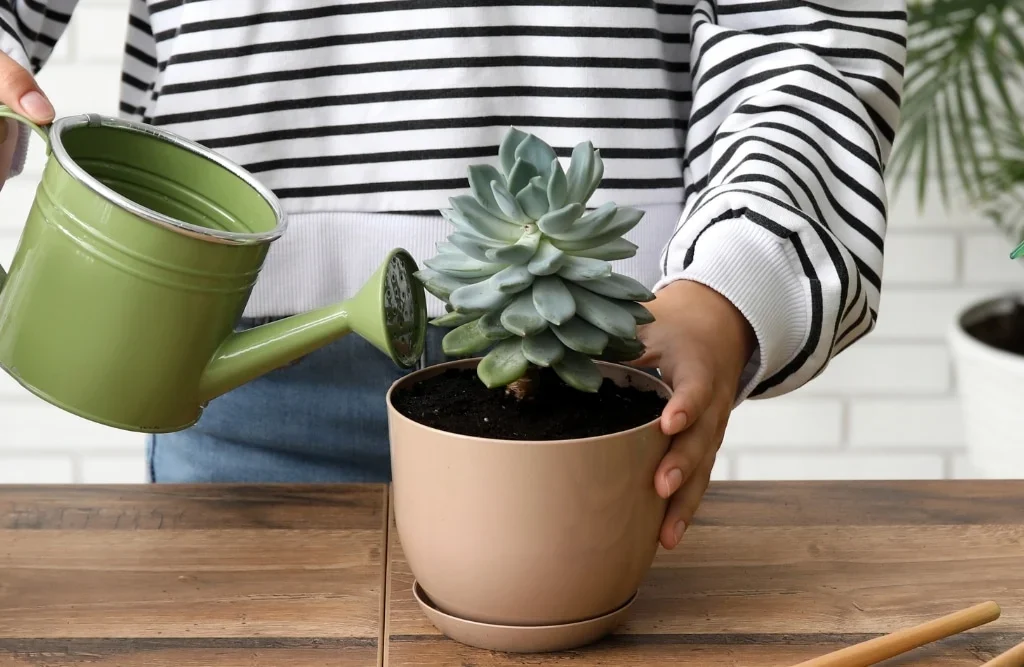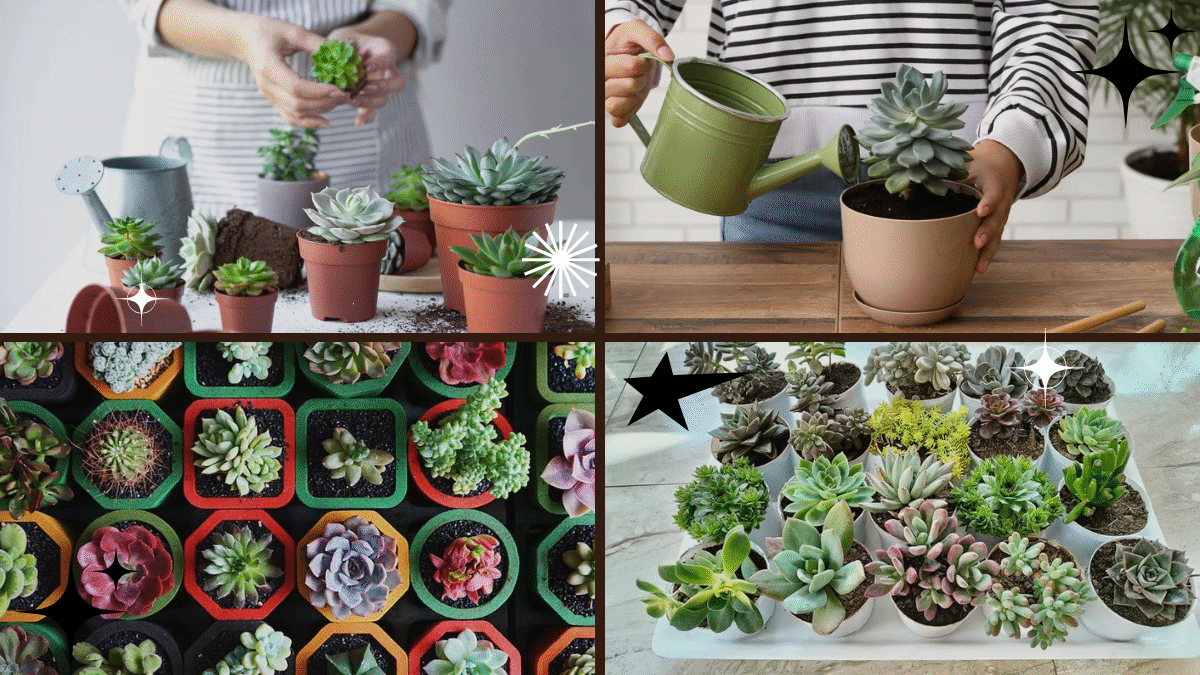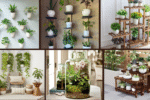Succulent plants have taken the world by storm, and for good reason! These charming, low-maintenance beauties are not only easy to care for but also incredibly versatile when it comes to home décor. From petite tabletop arrangements to statement wall displays, succulents add a fresh, modern touch to any indoor or outdoor space.
But while succulents are famously easygoing, they still need the right care to truly thrive. Whether you’re new to plant parenting or looking to up your succulent care game, this guide covers everything you need to know about how to take care of succulent plants and build your very own thriving indoor oasis.

What Are Succulents?
Succulents are a diverse group of plants known for their ability to store water in their leaves, stems, or roots. This feature allows them to survive in arid conditions where water is scarce. Popular succulent varieties include:
- Aloe Vera
- Echeveria
- Jade Plant
- Sedum
- Haworthia
- Cactus varieties
- String of Pearls
Each variety has its unique charm, but they all share a preference for bright light, well-draining soil, and infrequent watering.

Choosing the Right Spot
Light is one of the most crucial factors for keeping your succulents happy and healthy. Most succulent varieties crave bright, indirect sunlight.
Ideal placement ideas:
- South or east-facing windowsills
- Bright spots on a sunlit desk or shelf
- Outdoor patios during warm seasons (bring them indoors before frost)
Signs of too little light: Stretching, leaning, pale leaves, and sparse growth.
Signs of too much direct sun: Scorched, sunburned, or brown-tipped leaves.
Rotate your plants occasionally so all sides receive equal sunlight and grow evenly.

Picking the Perfect Soil
Succulents need well-draining soil to prevent root rot — their biggest enemy. Regular potting soil retains too much moisture, so it’s essential to use a mix specifically designed for cacti and succulents.
You can also DIY a mix by combining:
- 2 parts potting soil
- 1 part perlite or pumice
- 1 part coarse sand
This mix allows water to drain quickly and prevents excess moisture around the roots.

Choosing the Right Container
Equally important as soil is choosing the right container. Succulents need pots with drainage holes to allow excess water to escape.
Best container materials:
- Terracotta: Breathable and ideal for air circulation.
- Ceramic with drainage: Stylish and functional.
- Plastic pots: Lightweight and affordable but ensure good drainage.
Avoid keeping succulents in containers without drainage for long periods, as trapped moisture leads to root rot.
How to Water Succulents Properly
One of the most common mistakes succulent owners make is overwatering. Unlike tropical houseplants, succulents prefer to dry out completely between waterings.
Watering tips:
- Check the soil before watering; it should be completely dry.
- Water deeply until it drains from the bottom, then let it dry out again.
- In spring and summer (active growth season), water every 1-2 weeks.
- In fall and winter (dormant season), reduce watering to once a month or less.
Signs of overwatering: Mushy, translucent leaves and blackened stems.
Signs of underwatering: Wrinkled, shriveled leaves.
Fertilizing Succulents
Succulents aren’t heavy feeders but benefit from occasional fertilizing, especially during their active growing season.
Fertilizing tips:
- Use a balanced, diluted liquid fertilizer (half strength) formulated for succulents or houseplants.
- Feed once a month during spring and summer.
- Avoid fertilizing in fall and winter when the plant is dormant.
Too much fertilizer can cause rapid, weak growth and damage the plant.
Pruning and Maintenance
Pruning helps maintain a neat appearance and encourages healthy new growth.
Maintenance care includes:
- Removing dead, yellow, or shriveled leaves from the base.
- Cutting back leggy stems to maintain shape.
- Propagating cuttings to create new plants.
Use clean, sharp scissors or pruning shears to prevent disease.
Propagating Succulents
One of the joys of succulent care is how easily they propagate. You can multiply your collection by using leaves, cuttings, or offsets.
Propagation methods:
- Leaf Cuttings: Gently twist a healthy leaf off the stem, let it callous over for a few days, and place it on dry soil. Mist lightly every few days until roots form.
- Stem Cuttings: Cut a healthy stem, let it dry for a few days, then plant in dry, well-draining soil.
- Offsets (Pups): Remove baby plants growing at the base and pot them separately.
With patience, you’ll have a whole new batch of succulents in no time!
Providing Proper Air Circulation
Succulents love fresh air and need good airflow to prevent fungal diseases and pests like mealybugs.
Tips for good air circulation:
- Don’t overcrowd your plants.
- Use fans or open windows occasionally.
- Avoid placing plants too close together on a shelf or windowsill.
Dealing with Common Pests and Problems
While generally low-maintenance, succulents can occasionally face issues.
Common pests:
- Mealybugs: Look like tiny white cottony clusters.
- Aphids: Tiny green or black insects on new growth.
- Fungus gnats: Tiny flies attracted to overwatered soil.
Natural solutions:
- Remove pests with a cotton swab dipped in rubbing alcohol.
- Use insecticidal soap sprays for severe infestations.
- Let soil dry out to deter fungus gnats.
Seasonal Care Tips
Summer: Increase watering frequency as heat evaporates moisture faster.
Fall: Start reducing watering as daylight hours shorten.
Winter: Keep succulents in bright light, reduce watering, and avoid fertilizing.
Spring: Resume regular watering and feeding as new growth appears.
Creating Beautiful Succulent Displays
Succulents lend themselves to creative arrangements thanks to their variety of shapes, colors, and textures.
Fun display ideas:
- Mix multiple varieties in a shallow dish garden.
- Create hanging succulent baskets for windows or patios.
- Use vertical wall planters or frames for living art.
- Plant them in quirky containers like teacups, seashells, or driftwood.
Just remember — no matter the container, good drainage is non-negotiable!
Final Thoughts
Succulents are the perfect plant companions for beginners and seasoned plant parents alike. With their unique shapes, hardy nature, and forgiving care routine, they can brighten up any corner of your home while requiring minimal upkeep.
By following these detailed tips on how to take care of succulent plants, you’ll keep your indoor oasis lush, vibrant, and thriving year-round. From choosing the perfect light spot to mastering the art of watering and propagation, succulent care is as rewarding as it is easy.
So go ahead — expand your plant family and watch your home transform into a peaceful, green sanctuary. Your succulents will thank you with fresh growth and stunning displays of nature’s artistry.





Leave A Comment